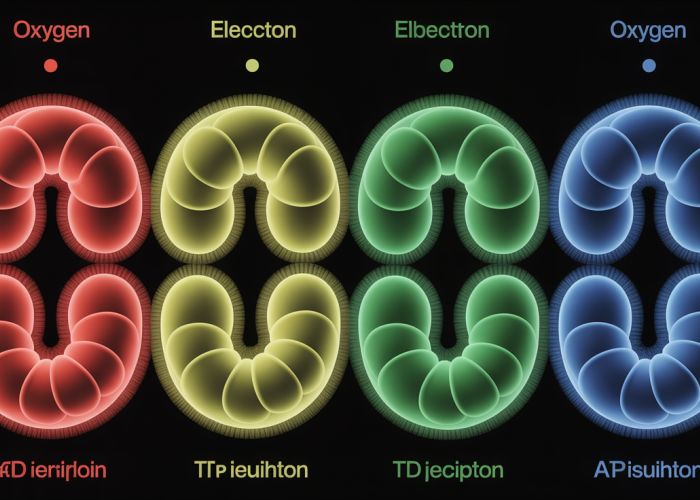Cellular Respiration, a vital process occurring within the Mitochondria, critically depends on the final electron carrier. This crucial molecule, often Oxygen (O₂) in aerobic organisms, accepts electrons after they travel through the electron transport chain. The ultimate goal is to generate the electrochemical gradient needed for ATP Synthase to produce ATP, the energy currency of the cell. Therefore, understanding the function of the final electron carrier is vital to comprehending how cells generate and store energy.

Optimizing Article Layout: Final Electron Carrier in Cellular Energy
A well-structured article on the "final electron carrier" is crucial for delivering a clear and impactful explanation of its role in cellular energy production. The following layout breaks down the topic into digestible sections, each designed to build upon the previous one.
Introduction: Setting the Stage
- Begin with a concise and engaging hook. For example: "Every cell in your body needs energy to function. But where does that energy come from, and what’s the final step in unlocking it?" This immediately establishes relevance.
- Briefly introduce the electron transport chain (ETC) as the process responsible for the majority of cellular energy production.
- Clearly state the central role of the "final electron carrier" within the ETC. Emphasize that it’s the last stop for electrons before the energy harvest.
- State the main goal of the article: To explain the identity of the final electron carrier and how it facilitates energy production.
The Electron Transport Chain: An Overview
- Provide a simplified overview of the ETC. Think of it as a chain of protein complexes embedded in the mitochondrial membrane (in eukaryotes).
- Describe the flow of electrons through the chain. Emphasize that electrons are passed from one complex to the next.
-
Explain that as electrons move, energy is released, which is used to pump protons (H+) across the membrane, creating an electrochemical gradient.
Location of the ETC: Where the Magic Happens
- Specifically mention the location of the ETC within the cell.
- Eukaryotes: Inner mitochondrial membrane
- Prokaryotes: Plasma membrane
- Include a simple diagram or illustration showing the location.
- Specifically mention the location of the ETC within the cell.
Identifying the Final Electron Carrier: Oxygen’s Crucial Role
- Introduce oxygen (O2) as the primary final electron carrier in aerobic respiration.
- Explain how oxygen accepts electrons and combines with protons to form water (H2O). This step is critical to "clearing" the ETC and allowing it to continue functioning.
- Equation: O2 + 4e- + 4H+ → 2H2O
-
Emphasize that without oxygen, the ETC would stall, and cellular energy production would drastically decrease.
Why Oxygen? The Chemistry Behind It
- Explain that oxygen is a very electronegative molecule.
- This high electronegativity means it has a strong pull on electrons, making it an ideal final electron acceptor.
- Contrast this to other potential electron acceptors, explaining why they are less efficient.
Alternative Final Electron Carriers: Anaerobic Respiration
- Introduce the concept of anaerobic respiration. This occurs when oxygen is not available.
- State that some organisms can use alternative molecules as final electron carriers.
-
Provide examples of alternative final electron carriers and the organisms that use them.
- Sulfate (SO42-): Used by some bacteria and archaea, producing hydrogen sulfide (H2S).
- Nitrate (NO3-): Used by denitrifying bacteria, producing nitrogen gas (N2).
- Carbon Dioxide (CO2): Used by methanogenic archaea, producing methane (CH4).
Table: Comparing Final Electron Carriers
Final Electron Carrier Organisms Product Environment Oxygen (O2) Most eukaryotes, many prokaryotes Water (H2O) Aerobic (oxygen-rich) Sulfate (SO42-) Some bacteria and archaea Hydrogen sulfide (H2S) Anaerobic (oxygen-poor), often marine sediments Nitrate (NO3-) Denitrifying bacteria Nitrogen gas (N2) Anaerobic, often soil Carbon Dioxide (CO2) Methanogenic archaea Methane (CH4) Anaerobic, often wetlands or digestive tracts
The Proton Gradient and ATP Synthesis: Energy Unlocked
- Explain that the movement of electrons through the ETC establishes a proton gradient (also known as the proton-motive force).
- Describe how this gradient is used by ATP synthase to produce ATP (adenosine triphosphate), the cell’s primary energy currency.
-
Explain the process of chemiosmosis: the coupling of the proton gradient to ATP synthesis.
ATP Synthase: The Molecular Motor
- Briefly describe the structure and function of ATP synthase.
- Explain that the flow of protons through ATP synthase causes it to rotate, driving the phosphorylation of ADP to ATP.
- Emphasize that this process is directly linked to the function of the final electron carrier because it is the proton gradient established by the ETC that fuels ATP synthesis.
FAQs: Final Electron Carrier in Cellular Energy
This FAQ section addresses common questions about the final electron carrier’s crucial role in generating cellular energy.
What exactly is the final electron carrier?
The final electron carrier is the molecule that accepts electrons at the very end of the electron transport chain. This acceptance is vital for completing the process that produces ATP, the cell’s energy currency.
Why is the final electron carrier so important?
Without the final electron carrier to accept electrons, the electron transport chain would halt. This would severely limit or completely stop ATP production, depriving the cell of the energy it needs to function.
What commonly serves as the final electron carrier?
In aerobic respiration, the most common final electron carrier is oxygen. Oxygen accepts the electrons and combines with hydrogen ions to form water, a harmless byproduct.
What happens if something interferes with the final electron carrier?
Interference with the final electron carrier, such as by certain poisons, can be deadly. Blocking the electron flow effectively shuts down cellular respiration, leading to rapid energy depletion and cell death.
So there you have it – a glimpse into the amazing world of the final electron carrier! Hopefully, you’ve gained a better understanding of this critical component of cellular energy production. Keep exploring, and stay energized!



